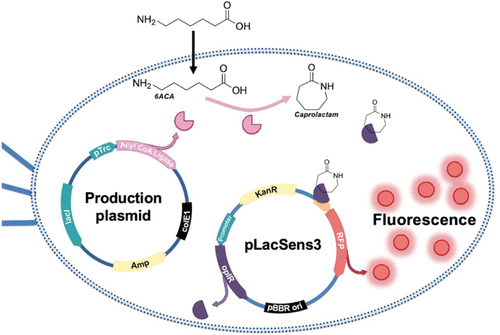当前位置:
X-MOL 学术
›
ACS Synth. Biol.
›
论文详情
Our official English website, www.x-mol.net, welcomes your
feedback! (Note: you will need to create a separate account there.)
Identification, Characterization, and Application of a Highly Sensitive Lactam Biosensor from Pseudomonas putida.
ACS Synthetic Biology ( IF 3.7 ) Pub Date : 2019-12-16 , DOI: 10.1021/acssynbio.9b00292 Mitchell G Thompson 1, 2, 3 , Allison N Pearson 1, 2 , Jesus F Barajas 2, 4 , Pablo Cruz-Morales 1, 2, 5 , Nima Sedaghatian 1, 2 , Zak Costello 1, 2, 4 , Megan E Garber 1, 2, 6 , Matthew R Incha 1, 2, 3 , Luis E Valencia 1, 2, 7 , Edward E K Baidoo 1, 2 , Hector Garcia Martin 1, 2, 4, 8 , Aindrila Mukhopadhyay 1, 2, 6 , Jay D Keasling 1, 2, 7, 9, 10, 11
ACS Synthetic Biology ( IF 3.7 ) Pub Date : 2019-12-16 , DOI: 10.1021/acssynbio.9b00292 Mitchell G Thompson 1, 2, 3 , Allison N Pearson 1, 2 , Jesus F Barajas 2, 4 , Pablo Cruz-Morales 1, 2, 5 , Nima Sedaghatian 1, 2 , Zak Costello 1, 2, 4 , Megan E Garber 1, 2, 6 , Matthew R Incha 1, 2, 3 , Luis E Valencia 1, 2, 7 , Edward E K Baidoo 1, 2 , Hector Garcia Martin 1, 2, 4, 8 , Aindrila Mukhopadhyay 1, 2, 6 , Jay D Keasling 1, 2, 7, 9, 10, 11
Affiliation

|
Caprolactam is an important polymer precursor to nylon traditionally derived from petroleum and produced on a scale of 5 million tons per year. Current biological pathways for the production of caprolactam are inefficient with titers not exceeding 2 mg/L, necessitating novel pathways for its production. As development of novel metabolic routes often require thousands of designs and result in low product titers, a highly sensitive biosensor for the final product has the potential to rapidly speed up development times. Here we report a highly sensitive biosensor for valerolactam and caprolactam from Pseudomonas putida KT2440 which is >1000× more sensitive to an exogenous ligand than previously reported sensors. Manipulating the expression of the sensor oplR (PP_3516) substantially altered the sensing parameters, with various vectors showing Kd values ranging from 700 nM (79.1 μg/L) to 1.2 mM (135.6 mg/L). Our most sensitive construct was able to detect in vivo production of caprolactam above background at ∼6 μg/L. The high sensitivity and range of OplR is a powerful tool toward the development of novel routes to the biological synthesis of caprolactam.
中文翻译:

恶臭假单胞菌的高灵敏度内酰胺生物传感器的鉴定,表征和应用。
己内酰胺是传统上由石油衍生的尼龙的重要聚合物前体,其年产量为500万吨。目前生产己内酰胺的生物学途径效率很低,效价不超过2 mg / L,因此需要新颖的生产途径。由于开发新的代谢途径通常需要数千个设计,并且导致产品滴度低,因此用于最终产品的高度灵敏的生物传感器具有迅速加快开发时间的潜力。在这里,我们报告了一种来自恶臭假单胞菌KT2440的戊内酰胺和己内酰胺的高度敏感的生物传感器,该传感器对外源配体的敏感性比以前报道的传感器高1000倍以上。操纵传感器oplR(PP_3516)的表达式会大大改变感应参数,各种载体的Kd值范围从700 nM(79.1μg/ L)到1.2 mM(135.6 mg / L)。我们最敏感的构建体能够以约6μg/ L的水平检测到体内己内酰胺的生成量。OplR的高灵敏度和高范围是开发生物合成己内酰胺的新途径的有力工具。
更新日期:2020-01-04
中文翻译:

恶臭假单胞菌的高灵敏度内酰胺生物传感器的鉴定,表征和应用。
己内酰胺是传统上由石油衍生的尼龙的重要聚合物前体,其年产量为500万吨。目前生产己内酰胺的生物学途径效率很低,效价不超过2 mg / L,因此需要新颖的生产途径。由于开发新的代谢途径通常需要数千个设计,并且导致产品滴度低,因此用于最终产品的高度灵敏的生物传感器具有迅速加快开发时间的潜力。在这里,我们报告了一种来自恶臭假单胞菌KT2440的戊内酰胺和己内酰胺的高度敏感的生物传感器,该传感器对外源配体的敏感性比以前报道的传感器高1000倍以上。操纵传感器oplR(PP_3516)的表达式会大大改变感应参数,各种载体的Kd值范围从700 nM(79.1μg/ L)到1.2 mM(135.6 mg / L)。我们最敏感的构建体能够以约6μg/ L的水平检测到体内己内酰胺的生成量。OplR的高灵敏度和高范围是开发生物合成己内酰胺的新途径的有力工具。











































 京公网安备 11010802027423号
京公网安备 11010802027423号